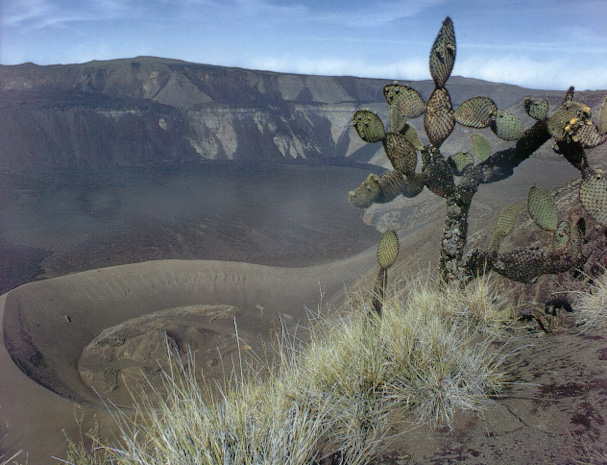|
Description of the Galapagos Islands Isla Cerro Azul  | | Isla Cerro Azul's Crater. Picture source: http://www.geo.cornell.edu/geology/GalapagosWWW/GalapagosGeology.html |
Cerro Azul volcano occupies the southwest corner of Isla Isabela (Albermarle Island). Although smaller than it neighbor to the west, Sierra Negra, at 1690 m (5541 feet) its summit is higher. Cerro Azul is quite active, with 9 known historic eruptions, the most recent of which began in Sept, 1998 and has continued into October (updated information about this eruption can be found on the Galapagos News page). That eruption was somewhat unusual because lava erupted both from a vent near the eastern base and from a vent within the caldera. Because of its remoteness, it is likely that many eruptions over the last several hundred years have gone unnoticed. The composition of Cerro Azul's lavas is quite uniform and rather similar to that of Sierra Negra's. Both Cerro Azul and Sierra Negra have strong enrichments in incompatible elements, indications that these melts are derived primarily from the Galapagos mantle plume rather than entrained asthenosphere.
Cerro Azul's caldera is elongate in a ENE-WMW direction and is among the smallest in the western Galapagos, measuring roughly 4 km by 3 km. Nevertheless, at 650 m (2000 ft), it is among the deepest of the calderas in the western Galapagos. The caldera is quite complex, with numerous embayments and benches, indicating it formed not in a single event, but through multiple collapses. A large cinder cone may be seen in the caldera floor. Numerous young flows erupted from an arcuate vent system on south rim of the caldera, and cascaded down the caldera wall to pond in the caldera floor. A lake has developed in the last decade or so and now occupies much of the northeast half of the caldera floor. Caldera lakes are not uncommon in the Galapagos, but they are rarely permanent.
|







